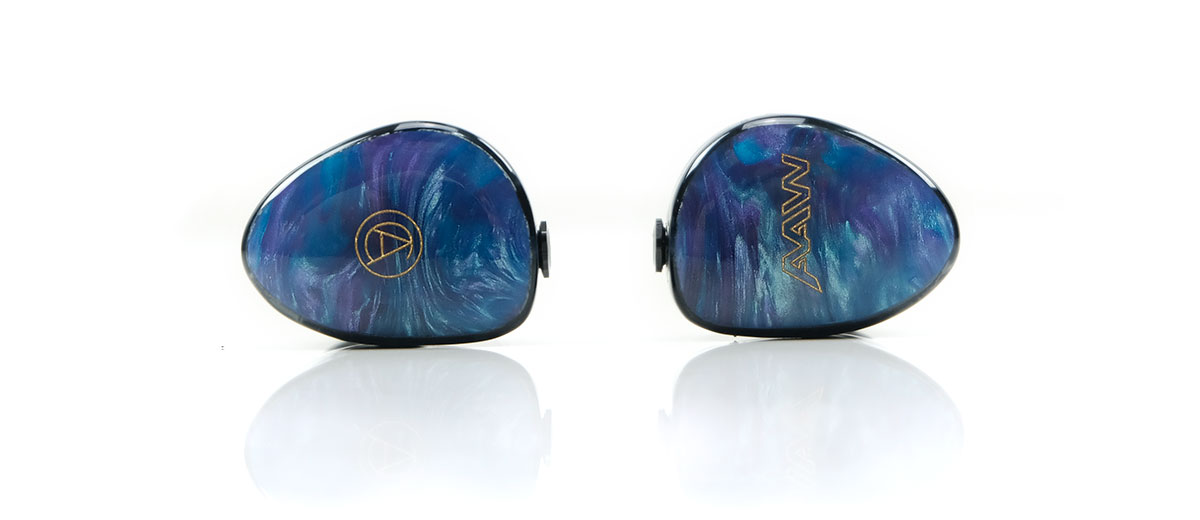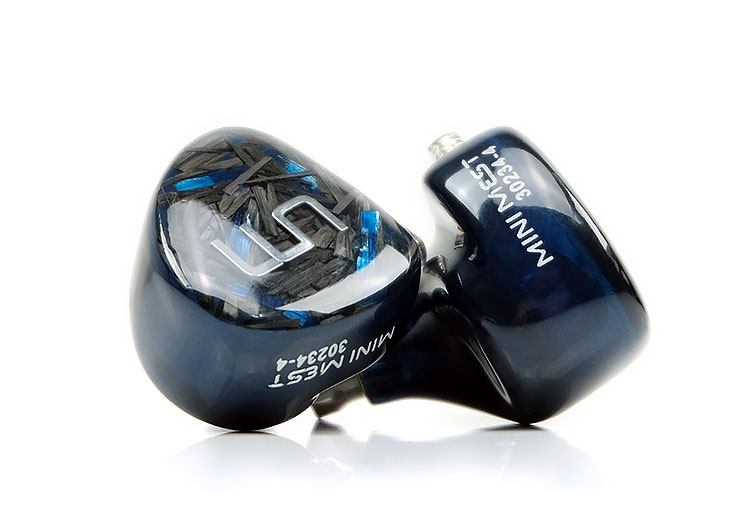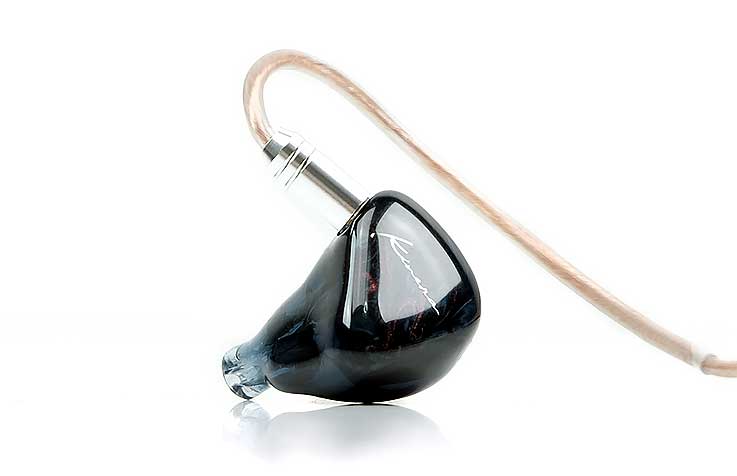Select Comparisons
(All comparisons tested with the Norm filter which we consider to be the Project 4+2 benchmark tuning).
DUNU DK-4001
$899
Technical
The DUNU DK-4001 is a universal hybrid monitor with a price point in the same ballpark as Project 4+2. This is a 5-driver single DD and 4 BA as opposed to 6 inside the project 4+2. Technically, the isobaric is a single mechanical unit but its dual-diaphragm operates as 2 dynamic drivers.
The isobaric driver inside Project 4+2 is smaller at 8mm compared to the 13mm beryllium coated dynamic driver inside the DK-4001, however, it covers a smaller frequency range. The Project 4+2 isobaric is primarily for the lows, whereas the DK-4001 dynamic driver covers both the lows and the mids.
The rest of the DK-4001 driver grouping is split between the highs and super highs, 2 BA apiece. Project 4+2 uses 3 FIBAE BA for the mids and the single NOVA driver for the highs. The DK-4001 does not use any tech such as FIBAE or NOVA, instead, its BA drivers are two Knowles SWFK-31736 dual-tweeters.
On paper, the DK-4001 is rated at 32Ω with an SPL of 112dB compared to Project 4+2’s less resistive 8Ω but also less sensitive 105dB SPL. Both are relatively easy to drive needing only low-gain output from something like the FiiO M15 and 50 to 55 clicks on the volume.
In our real-world testing with the Lotoo PAW Gold Touch SE output, both monitors actually tested quite similar with next to no adjustment between them required for volume matching.
Design
The DK-4001 has a much smaller form factor compared to Project 4+2 but it is heavier due to the use of a robust sandblasted matte-black zirconium liquid alloy material for its housing. Project 4+2 uses a lightweight acrylic material with a hollow body shell as well as a more aggressive curving and certainly more visually eye-catching design.
The tiny size of the DK-4001 does mean it uses a fairly long nozzle to fit securely in the ear. Project 4+2 technically has a shorter nozzle but the girth of the body means more of the shell is in use to create a seal and sit securely.
Both are very comfortable in all honesty and given they are both vented designs they also have similar levels of passive isolation. The one main advantage of the DK-4001 is the profile in the ear. Its size allows it to be much more discreet compared to Project 4+2.
A final remark on their cable systems. Both the Noble and Tiburon are good quality copper cables. In fact, DUNU’s Noble cable sells for $399 on its own which is a sizeable sum of money.
The DUNU Noble is a 1.2m cable consisting of alternating strands of Furukawa sourced OCC Copper and DHC pure silver wire in a 4-wire build. Project 4+2 Tiburon MKII has a bigger gauge at 24AWG using a Litz 5 geometry and cryogenically treated UPOCC monocrystalline copper conductor.
The Tiburon MKII should be the better sonic performer but the interchangeable jacks on the Noble might be priceless to multi-DAP or source users.
Performance
The key differences between these two monitor performances are a bit more nuanced than I had originally anticipated. Both have a gorgeous dynamic driver timbre on the low-end with plenty of welly and a nicely defined sub-bass thump. Both have a controlled treble that resists pushing into much sparkle. Two very nicely balanced hybrid tuning.
However, where are the differences? The key is really the DK-4001’s use of the dynamic driver up to the upper mids compared to the triple FIBAE BA in Project 4+2 taking over from the mids onwards. You get a little more neutrality and slightly superior articulation compared to the DK-4001’s slightly slower-paced but broader note texture in those mids.
On the low-end, yes, both have a fairly even sub-bass weight and density though you can up quantity that using Project 4+2’s bass filter. However, using the Norm filter, Project 4+2 has a bit more lift and sustain through the mid-bass to about 200Hz giving it a little more punch and warmth.
Both have a 1-2k lift but the DK-4001 lift seems a bit more forward sounding, perhaps due to the dynamic driver tone giving the vocals a bit more density compared to the slightly lighter but sweeter delivery of Project 4+2’s BA drivers. I also find Project 4+2’s BA implementation to offer a bit more micro-detail and better resolution through the mids.
On the top-end, the DK-4001 has a bit more lower-treble emphasis and a fade beyond 7k whereas Project 4+2 has a stronger 7-8k lift. You get a little more headroom and air on Project 4+2 as well as more of a neutral tone in the upper mids. The DK-4001 is more liquid sounding with the better body in upper mids percussion notes but not quite as much sparkle or clarity.
UM MEST Mini
$599
Technical
The MEST Mini is a popular hybrid monitor with a bit of a twist. Inside, it’s a triple BA configuration with a bone conduction driver overlapping the mids so technically a 4-driver configuration.
Interestingly, the MEST Mini also uses a custom-made open-air balanced armature driver design from Knowles and may have some similarities to the NOVA driver or the vented design favored by Custom Art.
The configuration for the MEST Mini is relatively simple with one BA for the lows, one for the mids and one for the highs. The bone conduction driver adds an additional layer across the mids and highs starting from around 1kHz.
Project 4+2 is much more complex with its dual diaphragm isobaric driver for the lows-, triple FIBAE BA for the mids and the NOVA BA driver for the highs using a 4-way passive and acoustic crossover.
The MEST Mini is rated at 23Ω and 113dB SPL compared to Project 4+2 which has an 8Ω and 105dB rating on paper. That’s how it played out with both the FiiO M15 and the Lotoo PAW Gold Touch using both their SE outputs in low-gain. The MEST Mini was just a little bit more sensitive by around 5-6 steps in both DAP volume controls and neither had any hiss issues going SE.
Design
Both monitors have acrylic builds with quasi-custom contouring though the MEST Mini is much smaller in terms of dimensions and a little lighter also. The lesser driver count in the MEST Mini will be a factor for the smaller size given the Project 4+2 uses 5 mechanical parts or 6 drivers, one of which is positioned inside the nozzle.
I do like the designs of both with the two monitors using a shade of blue and black. The MEST Mini uses a carbon fiber weave plate subtly interlaced with blue fibrous materials whereas Project 4+2 uses a more aggressive Midnight Lava lighter blue swirl faceplate.
One thing I am never dead keen on is the protruding stems of the MEST Mini 2-pin connector. It does make for a very secure and stable connection but makes for a weak rolling solution for alternative cables. The flush 2-pin socket of Project 4+2 is more universal and easily rollable though perhaps less secure.
The cable that comes with the MEST Mini is a 4-wire silver-plated copper wire, 26AWG in size wrapped in a relatively translucent jacket. It is quite light and attractively built with its two-tone color scheme and aluminum jack barrel.
However, the Tiburon MKII is another level for me with a bigger 24AWG wire, Litz 5 geometry, and cryogenically treated UPOCC monocrystalline copper conductor. The finishing is also better with a dedicated carbon fiber splitter barrel and matching jack barrel. Both have good handling but sonically, the Tiburon MKII is the better performer.
Performance
The initial impression you might get is wow, for a triple BA the MEST Mini has plenty of bass, perhaps more so than Project 4+2’s Norm filter. However, listening for a bit longer and taking a more studied approach you will start to hear the superior sub-bass density and definition in Project 4+2’s isobaric driver.
Granted, Project 4+2 does have a typically slower pace on the low-end with a longer decay but it seems more deliberate in its hits right at the bottom end whereas the MEST Mini is a bit vaguer and not quite as deliberate sounding.
You get an impression Project 4+2 is more in control with better separation through the low-end whereas the MEST Mini lacks the same resolution and texture and compensates by sheer quantity.
Through the mids, the MEST Mini dips a little harder from the upper bass to the lower-mids just before 1k. Project 4+2 carries a bit more warmth into the mids as well as tripling up the BA driver count.
The MEST Mini has some nice upper-mids presence but the instrumental and vocal body is a little thinner, particularly in the lower mids, whereas Project 4+2 sounds more natural, richer, and more rounded in its tone.
The top-end extension on both is good though the MEST Mini has a bit more of a 5-7k bias whereas Project 4+2 has more of a 7-8k bias allowing it to demonstrate a little more headroom, air, and sparkle. Neither have spikey aggressive treble, both are tuned very nicely and sound quite balanced. Rather, the 4+2 just has the slightly more satisfying percussion note body.
Kinera Nanna
$899.99
Technical
We reviewed the Nanna earlier last year and I was quite impressed actually by the performance of this hybrid universal IEM. The Nanna is a tribrid featuring dynamic, balanced armature, and electrostatic drivers whereas Project 4+2 uses isobaric and a mix of proprietary BA drivers.
Inside, the configuration is 4 driver assembly using a single custom 7mm dynamic driver, one full-range Sonion balanced armature driver, and a dual electrostatic Sonion tweeter. Kinera does not mention their crossover technology but we assume 3 or 4-way.
Project 4+2 works a 6 driver solution with that slightly larger 8mm dual-diaphragm isobaric purely for the lows, triple FIBAE BA for the mids, and the NOVA driver for the highs with a 4-way passive and acoustic crossover.
The Nanna is rated at a very high 60Ω impedance and a fairly sensitive 110dB SPL compared to Project 4+2’s far lower 8Ω impedance rating and a slightly less sensitive 105dB SPL. You need plenty of voltage swing for the Nanna to sound just right though both monitors will not need too much current.
There is a sizeable gap in volume requirements however with Project 4+2 running about 15 clicks below the Nanna on the FiiO M15 in low-gain SE and 10 clicks on the SE low-gain setting from the HiBy R8.
Design
Both monitors are lightweight acrylic designs though Project 4+2 is a little heavier and larger in terms of form factor. The Nanna has more aggressive shell contouring, a shallower body, and a longer nozzle whereas the Project 4+2 is a little bulkier with less contouring and a shorter nozzle.
Both have beautiful aesthetics though the Nanna is more subtle with a rich dark collage of blues and red that flow throughout the entire body including the faceplate. Project 4+2’s light blue ‘Midnight Lava’ swirl is the more eye-catching of the two color schemes. As ever, this will be a preference thing.
One thing to note, the Nanna has no lip on the end of its nozzle though the supplied tips seem to hold well in place. It also uses a bore termination rather than a wire gauze so might need a bit more cleaning.
Both are vented monitors so both have a degree of leakage from the shell so their passive isolation levels are relatively similar. The Nanna has a very slight comfort edge due to being smaller and lighter.
The stock cable is where Project 4+2 leaps ahead. The 24AWG wire, Litz 5 geometry, and cryogenically treated UPOCC monocrystalline copper conductor is a big step up over the 26AWG 4-wire copper cable from the Nanna. The finishing materials are also a higher grade in terms of the carbon-fiber splitter and jack barrel on the Tiburon MKII.
Performance
What stands out for me is the general instrumental note body and timbral coloration. Primarily because of the EST driver and the way Kinera has shaped the low-end to mid-range FR to give the Nanna a clean-sounding quality that is neutral to lean through the mids and highs compared to Project 4+2.
Project 4+2 sounds comparatively more natural to slightly warmer sounding with more mid-bass to lower-mids presence. It does not use an EST configuration for the highs so the BA texture remains consistent through the mids and highs also.
Neither does Project 4+2 have quite the same treble forwardness in its coloration as the Nanna nor the speedy top-end articulation which helps contribute to that more relaxed tone.
Both monitors have a very good level of low-end extension and you can pick out the sub-bass rumble on both when called upon. However, Project 4+2 retains its elevation a bit further up the FR from 40Hz almost up to 200Hz whereas the Nanna’s low-end is more L-shaped with the sub-bass the highest and less of a mid-bass and upper bass presence.
That means you get less of a mid-bass punch on the Nanna compared to Project 4+2 and a cooler timbre and more contrast on instrumental notes into the mids. You can pick out the greater bass to mids separation on the Nana whereas Project 4+2 transition is a little smoother.
Vocal presence on both is relatively forward but slightly more so on Project 4+2 unless very high pitching around 2-3k. Project 4+2 bumps around 1-2k and it’s not a huge push. Rather, its thicker sounding vocal timbre creates a broader and more natural vocal tone. Nanna’s vocal presence is good but lacking in a little even-harmonic weight and body so not quite the same gravitas.
Our Verdict
The AAW x Custom Art Project 4+2 offers some outstanding value to performance for its price point. I do not normally like to highlight price because it is such a subjective topic but in this case, I can make an exception.
You are getting a lot of technology trickle-down from each company’s higher-end models into this monitor, which, combined with a very mature and pleasing sound, should make this the type of IEM attractive to all but the most rabid bassheads.
Throw in a good quality aftermarket cable, some attractive design work, and the BassFlow Control system for even more flexibility, and it is really hard not to like what Project 4+2 offers.
Maybe this is a post-Covid wallet tightening thing but I do appreciate what is happening here. You no longer have to spend a ton to get such an excellent performance.
AAW x Custom Art Project 4+2
- Dual diaphragm 8 mm isobaric woofer
- 3 precision Balanced Armature drivers
- Nozzle-less Open Vented Armature (NOVA) driver
- 4-way passive + acoustic crossover design
- FIBAE™ technology flat impedance & phase design
- 3D-printed shells
- Null Audio Tiburon UPOCC copper cable
- Frequency response: 10 Hz – 40 kHz
- Sensitivity: 105 dB SPL@1kHz
- Impedance: 8 Ohm
- THD: <=0,5% @1mW@1kHz





